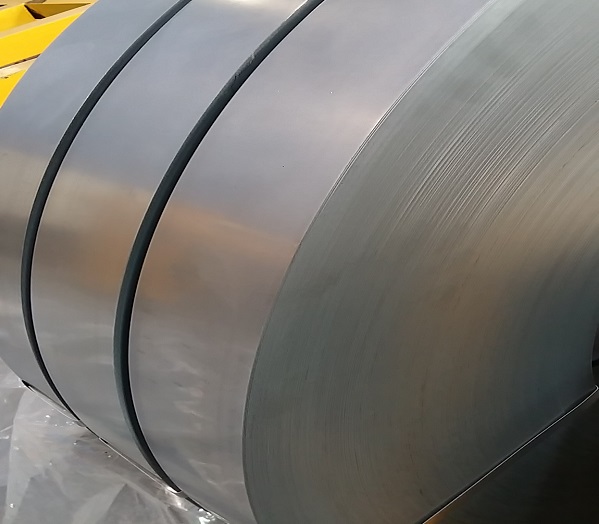Hardened & Tempered Steel Strip
Here at Ben Bennett Jr we have 3 top of the range hardening furnaces offering both water and lead quenching.
Our Hardening & Tempering lines guarantee a uniform state of stress throughout the steel, resulting in a strip that is able to meet demanding toleranced on edge camber and flatness - and is entirely free from 'waviness'. It is this kind of quality which our customers rely upon - and which Ben Bennett Jr. Ltd is proud to achieve.
Hardened and Tempered Steel Strip (also known as hardened and tempered High carbon steel strip or, hardened and tempered carbon spring steel strip) is the basic raw material from which many different components are made, substantially being spring-type applications ranging from clutch plate segments to washers, retractor springs and even to tree springs in riding saddles and traditional clock springs. These strip products are a specialty of the Company and considerable plant development has taken place in recent years to facilitate a very wide range of dimensions, mechanical properties and coil weights. Hardened and Tempered Steel Strip gauges of between 0.10mm and 2.00mm can be processed and, depending on the appropriate combination to suit the process equipment, strip widths of between 4.76mm to 240mm are produced. The facilities also allow up to 2000kg coils to be produced though most are well below this, being governed by a very approximate relationship of 100kg per 25mm of width.
The steel grades involved in this range of Hardened and Tempered Steel Strip products are the higher carbon steels, with the overall carbon range being 0.65 - 1.05%. Within this range are closely defined standards such as, in BS 1449 Part 1 1991, CS70, CS80 and CS95 specifications. Globally, these would be recognized as say AISI grades 1070, 1080 and 1095 and in the relatively recent European specification EN 10132-4 as C67S, C75S and C100S.
Technically, the Hardened and Tempered Steel Strip produced by the Company is that in the martensitic condition where high levels of hardness are achieved which are then accompanied by the appropriate ductility and shock resistance properties the user industries require. The heat treatments involved are carried out on continuous production lines, each line containing 2 furnaces, the first of which heats the steel to temperatures from which, after rapid cooling, the steel is fully hardened. At this stage the steel, whilst very hard, is also very brittle and it is the second furnace in the production line, the tempering furnace, that reheats the steel to temperatures at which the steel is softened slightly and develops some ductility and impact resistance. Typically, steel is hardened from temperatures of 880/920°C whereas the tempering process uses temperatures of 400 - 580°C and the selection of temperatures in this range is critical as it determines the final hardness (and tensile strength) of the steel. With the range of steel grades involved hardness levels of between 380 VPN to 650 VPN are possible, the steels with the highest carbon levels being most suitable for hardening to the upper ranges of hardness. With accurate tempering temperature control the range of hardness achieved on any one item can be restricted to 30 - 40 VPN. Thus, across the whole range of high carbon steels, a large number of very specifically-tailored strip products can be engineered for particular end-use applications.
These steels are most commonly produced with sheared edges and a slightly oxidized blue-black (also called blue-grey) finish, as these conditions are fully acceptable in engineering component manufacture. Steel strip with enhanced properties can be produced by edge machining the strip, either before or after the hardening and tempering process. The edge-dressed strip is material where the edge condition from the previous slitting process has been removed, in the Company's case by a very effective in-line, 2-sided machining process which removes the sheared edges which naturally contain a level of micro-cracks and are also of relatively rough nature. The dressed edge confers a substantial engineering benefit in improved fatigue-resistance properties, this being of particular value in arduous spring-type applications.
The strip edge can be machined to either round or square profiles, round being the preferred profile for fatigue-resistance benefits. A square edge has a more particular application in that it gives a high-quality reference plane for use in doctor blade applications where one strip edge is processed to the final blade profile used for example in the paper manufacturing industry.
A further benefit of edge dressing is to increase handling safety aspects where the sheared edges may be considered hazardous to the end applications. Whilst the mechanical properties of the strip are still the dominant factors, there may be personal contact with the end product or where the sheared edge may damage any coverings applied to the product. Examples of this would be where the steel is used in prosthetic limbs or even when covered with fabric such as in photographic reflectors.
The surface finish of Hardened and Tempered Steel Strip products is not too critical in general engineering applications where the normal blue-black (also known as blue-grey) oxidized finish from the heat treatment is satisfactory. By control of the atmospheres in the furnaces non-oxidised surfaces can also be produced, on a selected basis, and alternatively, steels can be satin or bright polished were needed, these finishes being as much for cosmetic reasons as for engineering purposes.
TYPICAL APPLICATIONS
Automobile Clutches, Clock Springs, Doctor Blades, Hand Tools, Saw Blades...
Unique specifications are also available.

.jpg)

.png)